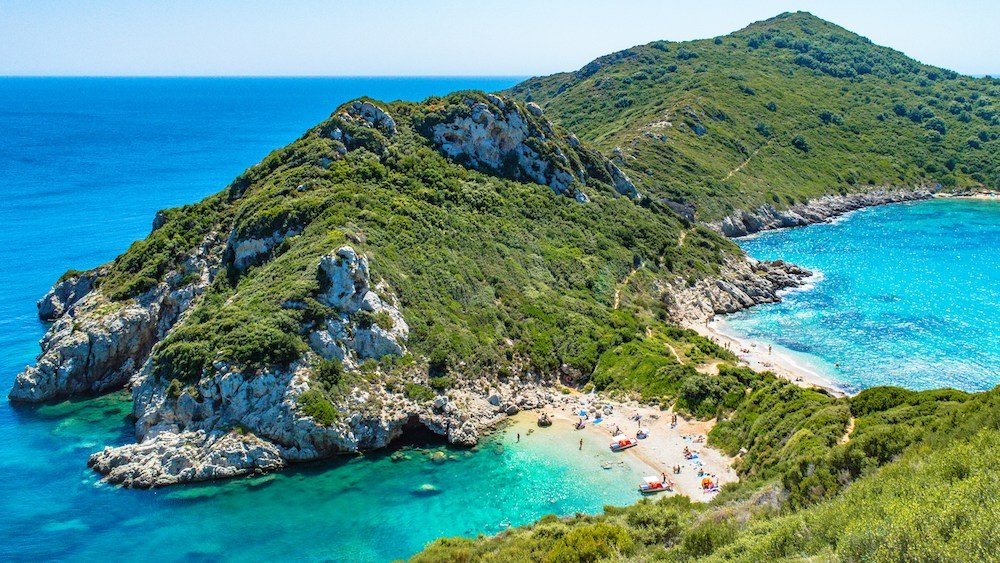
Volcanic islands, often referred to as “islands of fire,” are captivating landforms formed through volcanic activity.
These islands emerge from the ocean as a result of volcanic eruptions, creating stunning landscapes and unique ecosystems.
From the vast Pacific Ring of Fire to remote corners of the Atlantic and Indian Oceans, volcanic islands dot the world’s oceans, each telling a story of geological upheaval and natural beauty.
Volcanic islands play a crucial role in shaping the Earth’s geography and fostering diverse ecosystems.
Their formation contributes to the dynamic processes of plate tectonics and volcanic activity, influencing ocean currents, weather patterns, and geological landscapes.
Moreover, volcanic islands serve as natural laboratories for studying ecological succession, biodiversity, and the adaptation of life in extreme environments.
The purpose of this article is to delve into the mesmerizing world of volcanic islands by highlighting 12 of the most captivating examples across the globe.
From towering peaks crowned with lush vegetation to surreal lava fields sculpted by ancient eruptions, these islands offer a glimpse into the raw power and beauty of nature’s geological wonders.
Join us on an unforgettable journey as we uncover the secrets of these remarkable volcanic landscapes and discover the allure that draws adventurers, scientists, and nature enthusiasts to their shores.
Formation of Volcanic Islands

Volcanic activity is a powerful geological process characterized by the eruption of molten rock, ash, and gases from beneath the Earth’s crust.
This phenomenon occurs primarily at tectonic plate boundaries, where intense heat and pressure lead to the melting of rock and the formation of magma chambers.
As pressure builds within these chambers, magma is propelled upwards through fissures in the Earth’s crust, resulting in volcanic eruptions.
The formation of volcanic islands is a complex process influenced by various geological factors.
It typically begins with the accumulation of magma beneath the Earth’s surface, forming a magma chamber within the Earth’s crust.
As magma continues to rise, pressure builds until it breaches the surface, resulting in volcanic eruptions.
Over time, repeated eruptions lead to the accumulation of lava and volcanic debris, gradually building up the height and breadth of the volcanic island.
This process, known as volcanic accretion, contributes to the gradual expansion of the island’s landmass and the formation of distinct geological features such as volcanic cones, craters, and lava flows.
Types of Volcanic Islands
Volcanic islands exhibit a diverse range of shapes and geological characteristics, reflecting the unique conditions under which they form. Common types of volcanic islands include:
- Shield Volcanoes: Characterized by gently sloping profiles and broad, shield-like shapes, shield volcanoes form through the eruption of low-viscosity lava flows. These eruptions are typically non-explosive, allowing lava to flow long distances before solidifying, gradually building up the volcano’s structure over time.
- Stratovolcanoes (Composite Volcanoes): Stratovolcanoes are tall, conical mountains characterized by steep slopes and alternating layers of lava, ash, and volcanic debris. These volcanoes form through explosive eruptions that eject lava, ash, and pyroclastic flows, resulting in the accumulation of volcanic material around the vent.
- Calderas: Calderas are large, basin-shaped depressions formed by the collapse of a volcanic summit following a massive eruption or the emptying of a magma chamber. These formations can range in size from a few kilometers to several tens of kilometers in diameter and often contain secondary volcanic features such as lava domes and fumaroles.
Understanding the different types of volcanic islands provides insight into the diverse geological processes that shape these dynamic landforms, contributing to their unique landscapes and ecological characteristics.
Criteria for Selection
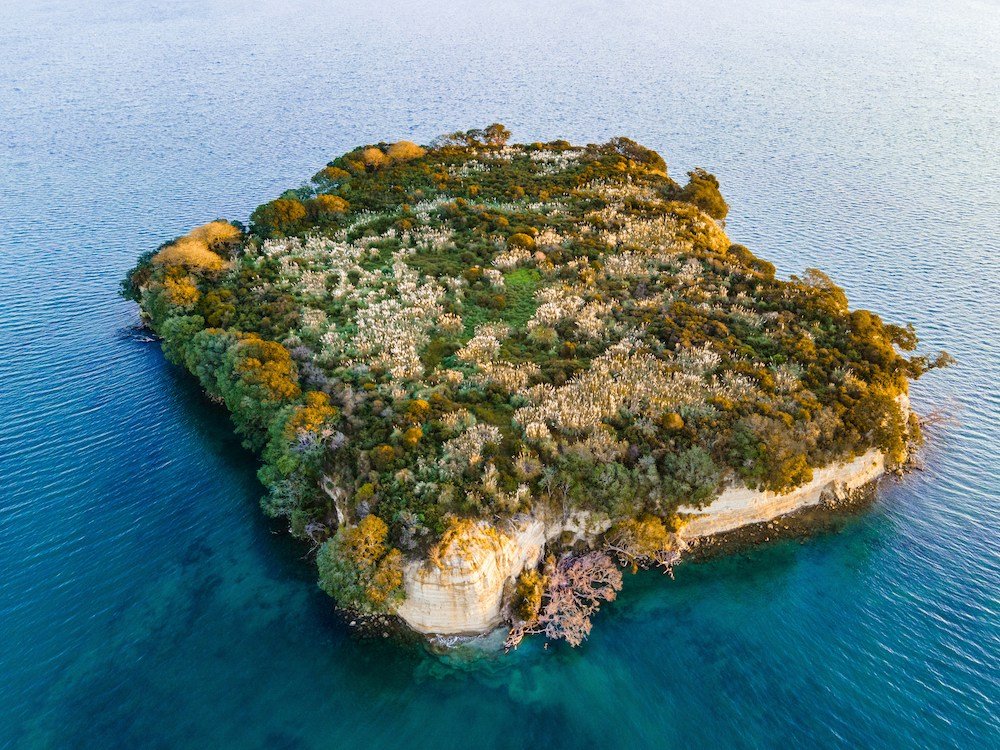
1. Factors Considered for Selecting the Most Fascinating Volcanic Islands
Selecting the most fascinating volcanic islands involves considering a variety of factors that contribute to their allure and significance. These factors include:
- Geological uniqueness and diversity of volcanic features
- Biodiversity and ecological importance of the island’s ecosystems
- Cultural heritage and historical significance
- Accessibility and opportunities for exploration and adventure
- Geological activity and volcanic phenomena
- Natural beauty and scenic landscapes
By evaluating these criteria, we can identify volcanic islands that offer a rich tapestry of geological wonders, cultural heritage, and natural beauty, making them truly captivating destinations for exploration and discovery.
2. Geographic Diversity
Geographic diversity is a key consideration in selecting fascinating volcanic islands, as it encompasses a wide range of landscapes, climates, and geological formations.
From the tropical paradises of the Pacific Ocean to the rugged coastlines of the Atlantic and Indian Oceans, volcanic islands can be found in diverse settings across the globe.
Each region offers its own unique blend of geological features, cultural traditions, and natural wonders, providing travelers with a wealth of experiences to discover and explore.
3. Cultural Significance
The cultural significance of volcanic islands is another important criterion for selection, as it reflects the rich history, traditions, and heritage of the island’s inhabitants.
Many volcanic islands are home to indigenous communities whose lives and livelihoods are deeply intertwined with the volcanic landscapes that surround them.
From ancient myths and legends to modern-day rituals and celebrations, the cultural heritage of these islands offers valuable insights into the human experience and our relationship with the natural world.
4. Unique Geological Features
One of the defining characteristics of volcanic islands is their unique geological features, which are shaped by millions of years of volcanic activity and natural processes.
These features can include:
- Volcanic cones and craters
- Lava flows and lava tubes
- Hot springs and geothermal areas
- Sea cliffs and coastal formations
- Volcanic lakes and calderas
Each volcanic island boasts its own array of geological wonders, providing scientists, explorers, and nature enthusiasts with endless opportunities for discovery and research.
By considering these criteria, we can identify 12 of the world’s most fascinating volcanic islands, each offering a unique blend of geological, cultural, and natural attractions that make them truly extraordinary destinations.
The 10 Most Fascinating Volcanic Islands
1. Nishinoshima Island, Tokyo
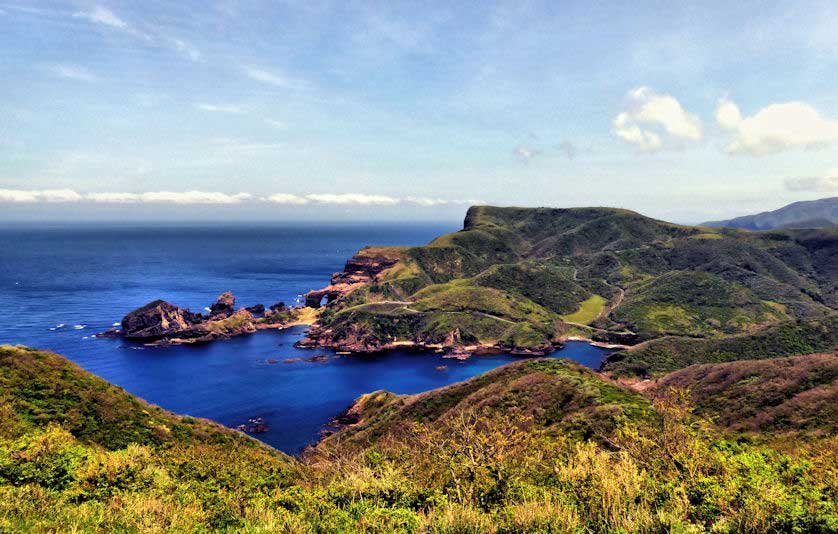
Nishinoshima Island is a remote volcanic island located in the Ogasawara Archipelago, approximately 940 kilometers south of Tokyo, Japan.
It emerged from the Pacific Ocean through a series of volcanic eruptions, with its most recent significant eruption occurring in 2013, leading to the expansion of its landmass and the formation of new geological features.
Nishinoshima Island is characterized by its dynamic volcanic landscape, featuring rugged coastlines, dramatic sea cliffs, and pristine beaches.
The island’s topography is shaped by volcanic activity, with numerous volcanic cones and craters dotting its terrain.
The island’s most prominent feature is Nishinoshima Volcano, a stratovolcano that rises to an elevation of approximately 270 meters above sea level.
One of the most remarkable attractions on Nishinoshima Island is the ongoing volcanic activity, which provides visitors with a rare opportunity to witness the raw power of nature in action.
The island’s volcanic eruptions have led to the formation of new landmasses, including lava deltas and lava flows, which continue to shape the island’s landscape.
In addition to its volcanic features, Nishinoshima Island is home to diverse flora and fauna, including unique species of plants and seabirds that have adapted to the island’s harsh volcanic environment.
Visitors can explore the island’s natural beauty through hiking trails and observation points, offering panoramic views of the surrounding ocean and neighboring islands.
While Nishinoshima Island is primarily known for its geological wonders, it also holds cultural significance for the indigenous communities of the Ogasawara Archipelago.
The island’s rich history is intertwined with the traditions and heritage of its inhabitants, who have lived in harmony with the volcanic landscape for centuries.
As a designated UNESCO World Heritage Site, Nishinoshima Island serves as a living testament to the enduring relationship between humans and nature, offering valuable insights into the resilience and adaptability of life in extreme environments.
2. Milos Island, Greece

Milos Island is a captivating volcanic island located in the Aegean Sea, part of the Cyclades archipelago in Greece.
Renowned for its stunning landscapes, pristine beaches, and rich geological diversity, Milos Island has long been a destination of choice for travelers seeking natural beauty and cultural heritage.
Milos Island boasts a diverse range of geological features shaped by volcanic activity and erosion over millions of years.
The island’s landscape is characterized by rugged coastlines, volcanic cliffs, and picturesque bays carved out of volcanic tuff and ash.
One of the most iconic geological formations on Milos is Sarakiniko Beach, known for its lunar-like landscape of white volcanic rock sculpted by wind and waves.
Milos Island is home to a wealth of natural and cultural attractions that showcase its unique beauty and heritage.
Visitors can explore the island’s volcanic landscapes through hiking trails, boat tours, and guided excursions to iconic landmarks such as:
- The Catacombs of Milos: An ancient Christian burial site dating back to the 1st century AD, featuring intricate catacombs carved into the volcanic rock.
- The Ancient Theatre of Milos: A well-preserved ancient amphitheater overlooking the sea, offering breathtaking views and cultural performances during the summer months.
- The Fishing Village of Klima: A charming seaside village renowned for its colorful fishermen’s houses, carved into the cliffs and adorned with vibrant murals depicting scenes of daily life.
Milos Island holds significant cultural importance as a center of civilization and trade throughout the ages.
From ancient times to the present day, the island has been inhabited by various civilizations, including the Minoans, Mycenaeans, Romans, and Venetians, each leaving their mark on its rich tapestry of history and heritage.
The island’s cultural legacy is evident in its archaeological sites, museums, and traditional villages, where visitors can immerse themselves in the vibrant traditions and customs of the local community.
From traditional festivals and religious celebrations to culinary delights and artisan crafts, Milos Island offers a unique glimpse into the timeless allure of Greek island life.
3. Barren Island, India

Barren Island, situated in the Andaman Sea, is a remote volcanic island located approximately 135 kilometers northeast of Port Blair, the capital of the Andaman and Nicobar Islands, India.
It stands as one of the few active volcanic islands in South Asia, drawing the interest of geologists, adventurers, and nature enthusiasts alike.
Barren Island is characterized by its rugged, volcanic terrain, dominated by the imposing presence of Barren Volcano, the only active volcano in India.
The island’s landscape is shaped by centuries of volcanic activity, with its towering volcanic cone rising dramatically from the sea.
Barren Volcano’s last major eruption occurred in 2017, sending plumes of ash and smoke into the sky, underscoring the island’s dynamic geological nature.
Despite its inhospitable environment, Barren Island offers a unique opportunity for exploration and discovery.
Visitors can witness the raw power of nature as they observe volcanic activity and witness the island’s ever-changing landscape.
Snorkeling and diving enthusiasts are drawn to the island’s vibrant underwater ecosystem, home to an array of marine life, including colorful coral reefs and exotic fish species.
While Barren Island’s cultural significance may not be as pronounced as its geological allure, it holds a special place in the folklore and mythology of the indigenous tribes of the Andaman and Nicobar Islands.
The island’s remote location and rugged terrain have long captivated the imagination of seafarers and explorers, serving as a beacon of mystery and adventure in the vast expanse of the Indian Ocean.
4. Sumatra Island, Indonesia

Sumatra Island, located in western Indonesia, is the sixth-largest island in the world and is renowned for its rich cultural heritage, stunning landscapes, and biodiversity.
Home to over 50 active volcanoes, Sumatra is a land of contrasts, where dense rainforests, pristine beaches, and towering volcanic peaks converge to create a mesmerizing tapestry of natural beauty.
Sumatra Island is part of the Pacific Ring of Fire, a region known for its intense volcanic activity and tectonic instability.
The island’s geological landscape is shaped by the collision of several tectonic plates, resulting in the formation of numerous volcanic mountains and geothermal hotspots.
Among the most iconic volcanoes on Sumatra are Mount Sinabung, Mount Kerinci, and Mount Merapi, each with its own unique characteristics and geological history.
Sumatra Island is home to a wealth of natural wonders and cultural treasures that attract visitors from around the world.
From the lush rainforests of Gunung Leuser National Park to the pristine beaches of Lake Toba, the largest volcanic lake in the world, Sumatra offers endless opportunities for exploration and adventure.
Other notable landmarks include the ancient Hindu temples of Prambanan and Borobudur, which stand as testaments to the island’s rich cultural heritage and architectural prowess.
Sumatra Island is inhabited by a diverse array of ethnic groups, each with its own unique customs, traditions, and languages.
The island’s cultural landscape is shaped by centuries of trade, migration, and colonial influence, resulting in a vibrant tapestry of ethnic diversity and cultural exchange.
Visitors to Sumatra can immerse themselves in the island’s rich cultural heritage through traditional ceremonies, dance performances, and culinary delights, gaining valuable insights into the lives and traditions of the local communities.
5. Ambrym Island, Vanuatu
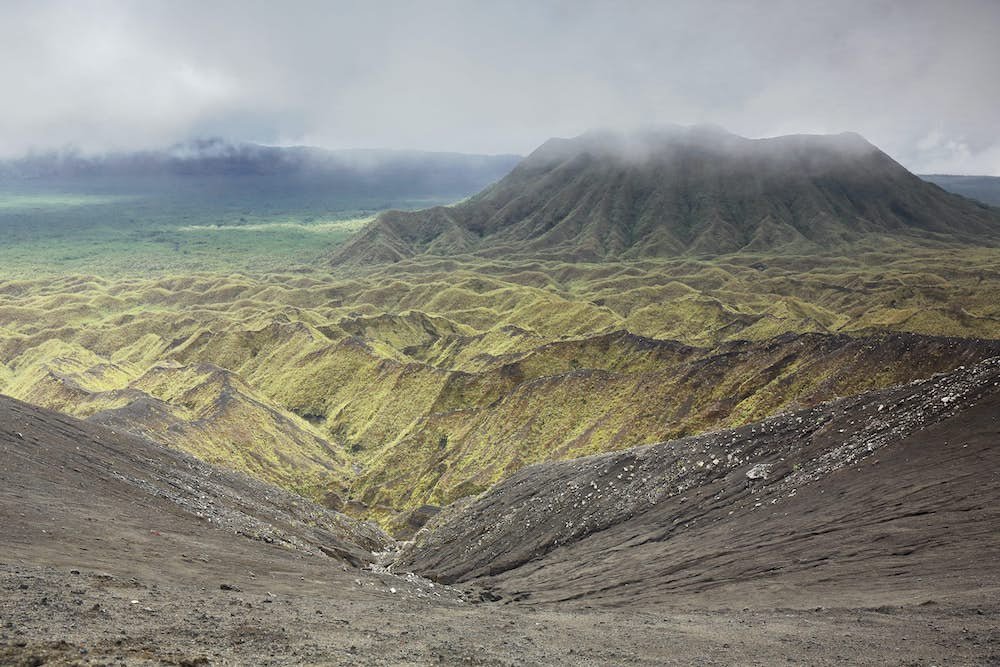
Ambrym Island is a volcanic island located in the South Pacific Ocean, part of the archipelago nation of Vanuatu.
Known for its rugged terrain, dense rainforests, and active volcanoes, Ambrym Island is a haven for adventurers and nature enthusiasts seeking to explore its otherworldly landscapes and vibrant cultural heritage.
Ambrym Island is home to two of the most active and accessible volcanoes in Vanuatu: Mount Marum and Mount Benbow.
These volcanoes are renowned for their persistent volcanic activity, including frequent eruptions, lava lakes, and volcanic gas emissions.
The island’s volcanic landscape is characterized by rugged lava fields, ash plains, and volcanic cones, creating a surreal and otherworldly atmosphere that captivates visitors from around the world.
One of the most iconic landmarks on Ambrym Island is the twin volcanic cones of Mount Marum and Mount Benbow, which offer breathtaking views of lava lakes and volcanic craters.
Adventurous travelers can embark on guided treks to the summit of these volcanoes, where they can witness the raw power of nature up close and personal.
Other notable attractions include lush rainforests, hidden waterfalls, and traditional villages, where visitors can immerse themselves in the rich cultural heritage of the island.
Ambrym Island is home to a vibrant indigenous culture, with traditional practices and customs that have been passed down through generations.
The island’s inhabitants, known as Ni-Vanuatu, have a deep spiritual connection to the land and its volcanic landscape, which plays a central role in their daily lives and cultural traditions.
Visitors to Ambrym Island can experience the warmth and hospitality of the local community through traditional ceremonies, dance performances, and cultural exchanges, gaining valuable insights into the island’s rich cultural heritage and way of life.
6. Stromboli Island, Italy

Stromboli Island, located in the Tyrrhenian Sea, is part of the Aeolian archipelago off the northern coast of Sicily, Italy.
Renowned for its active volcano, Stromboli is often referred to as the “Lighthouse of the Mediterranean” due to its frequent volcanic activity, which illuminates the night sky with spectacular eruptions of lava and ash.
The island’s rugged coastline, black sand beaches, and picturesque villages make it a popular destination for travelers seeking adventure and natural beauty.
At the heart of Stromboli Island lies the Stromboli Volcano, one of the most active volcanoes in the world.
With nearly continuous eruptions occurring at regular intervals, Stromboli offers visitors a rare opportunity to witness the primal forces of nature in action.
The volcano’s iconic summit crater, known as the “Sciara del Fuoco,” is a mesmerizing sight, with lava flows cascading down its slopes into the sea below.
Stromboli Island is home to a variety of natural and cultural attractions that showcase its unique charm and allure.
Visitors can explore the island’s volcanic landscapes through guided hiking tours to the summit of Stromboli Volcano, where they can witness the awe-inspiring spectacle of volcanic eruptions against the backdrop of the Mediterranean Sea.
Other notable landmarks include the quaint villages of Stromboli and San Vincenzo, where visitors can immerse themselves in the island’s rich history and vibrant culture.
Stromboli Island holds significant cultural importance as a symbol of resilience and adaptation in the face of natural adversity.
Despite the constant threat of volcanic activity, the island’s inhabitants have thrived for centuries, forging a deep connection to the land and sea that sustains them.
The island’s rich cultural heritage is evident in its traditional festivals, cuisine, and artisan crafts, which reflect the unique blend of influences from across the Mediterranean region.
7. Surtsey Island, Iceland
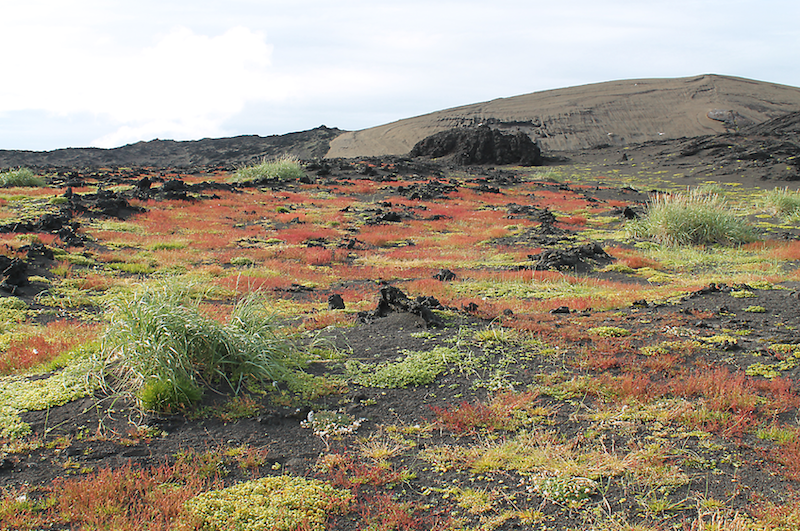
Surtsey Island is a volcanic island located off the southern coast of Iceland, in the North Atlantic Ocean.
It was formed through a series of volcanic eruptions that began in 1963 and continued for several years, making it one of the youngest islands on Earth.
Surtsey’s emergence from the sea and subsequent evolution provide scientists with a unique opportunity to study the process of island formation and ecological succession in real-time.
Surtsey Island is renowned for its pristine and unspoiled landscapes, characterized by rugged coastlines, volcanic craters, and dynamic geological formations.
The island’s volcanic soils are rich in minerals and nutrients, creating fertile conditions for the establishment of plant and animal life.
Surtsey’s geology is constantly evolving, shaped by ongoing volcanic activity, erosion, and the forces of nature.
As a designated UNESCO World Heritage Site, Surtsey Island offers visitors a rare opportunity to witness the natural processes of island formation and ecological development firsthand.
Guided tours of the island provide insights into its geological history, showcasing its unique volcanic landscapes and diverse flora and fauna.
Visitors can explore the island’s volcanic craters, lava fields, and coastal cliffs, marveling at the raw power and beauty of nature’s creative forces.
While Surtsey Island may not have significant cultural significance in the traditional sense, it holds immense value as a living laboratory for scientific research and environmental conservation.
The island’s remote location and protected status ensure that it remains largely untouched by human activity, providing scientists with invaluable insights into the natural processes of island colonization and ecosystem development.
Surtsey serves as a testament to the resilience and adaptability of life in extreme environments, offering valuable lessons for conservation efforts worldwide.
8. Gran Canaria Island, Spain

Gran Canaria Island is one of the Canary Islands, an archipelago located in the Atlantic Ocean off the northwestern coast of Africa.
As the third-largest island in the Canary Islands chain, Gran Canaria is celebrated for its diverse landscapes, ranging from sandy beaches and coastal dunes to rugged mountains and volcanic craters.
The island’s mild climate, rich biodiversity, and vibrant culture make it a popular destination for travelers seeking sun, sea, and adventure.
Gran Canaria Island is of volcanic origin, shaped by millions of years of volcanic activity and geological processes.
The island’s central region is dominated by the dramatic peaks of the central massif, including Pico de las Nieves, the highest point on the island, and Roque Nublo, an iconic rock formation revered by the indigenous Guanche people.
The island’s volcanic heritage is evident in its rugged terrain, deep ravines, and volcanic cones, which offer breathtaking vistas and opportunities for exploration.
Gran Canaria Island boasts a wealth of natural and cultural attractions that showcase its unique charm and allure.
Visitors can explore the island’s diverse landscapes through hiking trails, scenic drives, and guided excursions to iconic landmarks such as Maspalomas Dunes, a protected natural reserve renowned for its golden sand dunes and pristine beaches.
Other notable attractions include the historic neighborhoods of Vegueta and Triana in the capital city of Las Palmas, where visitors can immerse themselves in the island’s rich history and cultural heritage.
Gran Canaria Island has a rich cultural heritage shaped by centuries of history, migration, and trade.
The island’s indigenous Guanche population, who inhabited the island prior to the arrival of the Spanish conquistadors, left behind a legacy of art, architecture, and folklore that continues to resonate to this day.
Visitors to Gran Canaria can experience the island’s cultural diversity through traditional festivals, music, and cuisine, which reflect a blend of Spanish, African, and indigenous influences.
9. Fogo Island, Canada
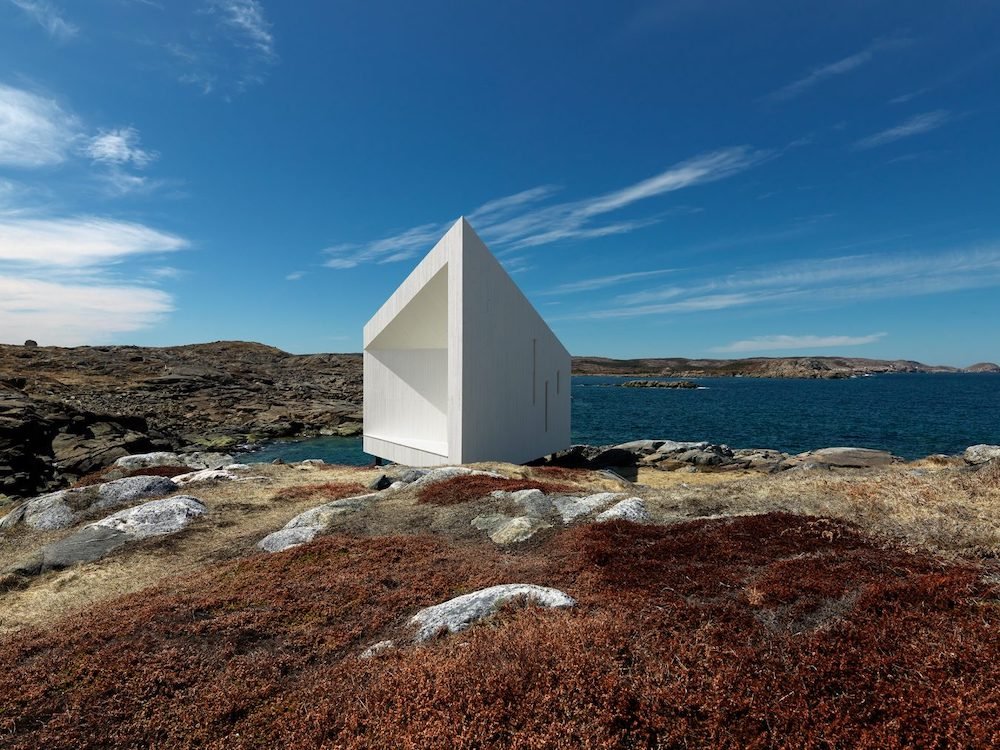
Fogo Island is a remote volcanic island located off the northeastern coast of Newfoundland, Canada.
Situated in the North Atlantic Ocean, Fogo Island is known for its dramatic landscapes, rugged coastline, and vibrant cultural heritage.
The island’s name, “Fogo,” is Portuguese for “fire,” a fitting homage to its volcanic origins and the fiery spirit of its inhabitants.
Fogo Island is characterized by its unique geological formations, shaped by volcanic activity and glaciation over millions of years.
The island’s rugged terrain is punctuated by towering sea cliffs, rocky shorelines, and verdant valleys, providing a stunning backdrop for outdoor exploration and adventure.
One of the most iconic geological features on Fogo Island is Brimstone Head, a rocky promontory that offers panoramic views of the surrounding landscape and the vast expanse of the Atlantic Ocean.
Fogo Island is home to a variety of natural and cultural attractions that showcase its rich history and natural beauty.
Visitors can explore the island’s scenic hiking trails, pristine beaches, and historic fishing villages, gaining insights into the traditional way of life and the island’s maritime heritage.
Other notable landmarks include the Fogo Island Inn, a world-renowned luxury hotel and cultural center designed by architect Todd Saunders, which serves as a hub for artists, writers, and travelers seeking inspiration and relaxation.
Fogo Island has a rich cultural heritage shaped by centuries of seafaring tradition, immigration, and community resilience.
The island’s inhabitants, known as “Fogo Islanders,” have a deep connection to the land and sea, which sustains their livelihoods and shapes their way of life.
Visitors to Fogo Island can experience the warmth and hospitality of the local community through traditional music, dance, and cuisine, gaining insights into the island’s vibrant cultural traditions and the spirit of resilience that defines its people.
10. Bora Bora Island, French Polynesia
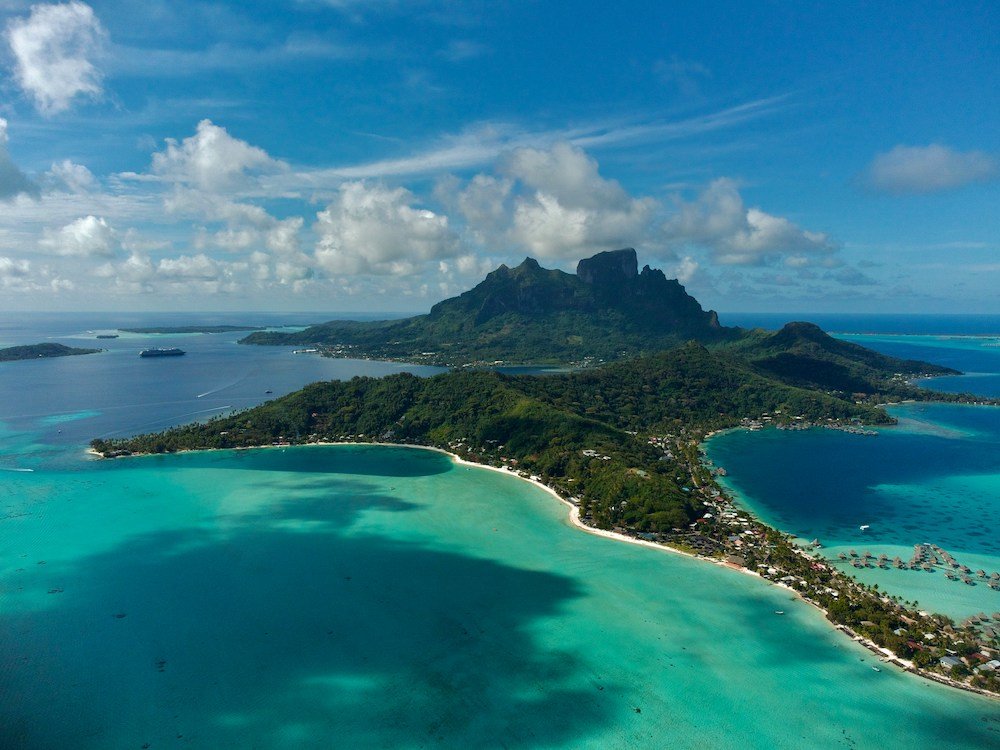
Bora Bora Island is a tropical paradise located in the South Pacific Ocean, part of the Society Islands archipelago in French Polynesia.
Renowned for its crystal-clear turquoise waters, pristine white-sand beaches, and iconic overwater bungalows, Bora Bora is often hailed as one of the most beautiful islands in the world.
Its idyllic setting, rich marine life, and luxurious resorts make it a dream destination for honeymooners, adventure-seekers, and luxury travelers alike.
Bora Bora Island is a remnant of an ancient volcanic caldera, surrounded by a vibrant coral reef and turquoise lagoon.
The island’s dramatic peaks, including Mount Otemanu and Mount Pahia, rise majestically from the center of the island, offering breathtaking views of the surrounding lagoon and neighboring islands.
Bora Bora’s geological heritage is evident in its rugged landscapes, lush tropical vegetation, and pristine beaches, which provide a stunning backdrop for relaxation and exploration.
Bora Bora Island is home to a variety of iconic landmarks and attractions that showcase its natural beauty and allure.
Visitors can embark on snorkeling and diving adventures to explore the vibrant coral reefs and marine life that thrive in the island’s crystal-clear waters.
Other popular activities include hiking to the summit of Mount Otemanu, indulging in spa treatments at luxurious resorts, and enjoying sunset cruises around the island’s picturesque lagoon.
Bora Bora’s overwater bungalows, with their thatched roofs and panoramic views, offer a unique and luxurious accommodation option for travelers seeking an unforgettable tropical getaway.
While Bora Bora Island is primarily known for its natural beauty and luxury tourism, it also holds cultural significance as a sacred and spiritual place for the indigenous Polynesian people.
The island’s traditional culture, customs, and legends are deeply rooted in the land and sea, with ancient rituals and ceremonies honoring the spirits of the ancestors and the natural world.
Visitors to Bora Bora can experience the warmth and hospitality of the local community through cultural performances, traditional crafts, and culinary delights, gaining insights into the rich heritage and timeless allure of the island paradise.
Conclusion
In this article, we embarked on a journey to explore 10 of the world’s most captivating volcanic islands, each offering a unique blend of natural beauty, geological wonders, and cultural heritage.
From the rugged landscapes of Nishinoshima Island in Japan to the tropical paradise of Bora Bora Island in French Polynesia, these volcanic islands invite travelers to immerse themselves in the wonders of the natural world and discover the secrets of their volcanic origins.
Volcanic islands play a crucial role in global geography and biodiversity, shaping landscapes, ecosystems, and human societies in profound ways.
These islands are not only hotbeds of geological activity but also serve as biodiversity hotspots, supporting a rich array of plant and animal life found nowhere else on Earth.
From the lush rainforests of Gran Canaria Island to the stark volcanic landscapes of Surtsey Island, each island offers valuable insights into the dynamic interplay between geology, ecology, and culture.
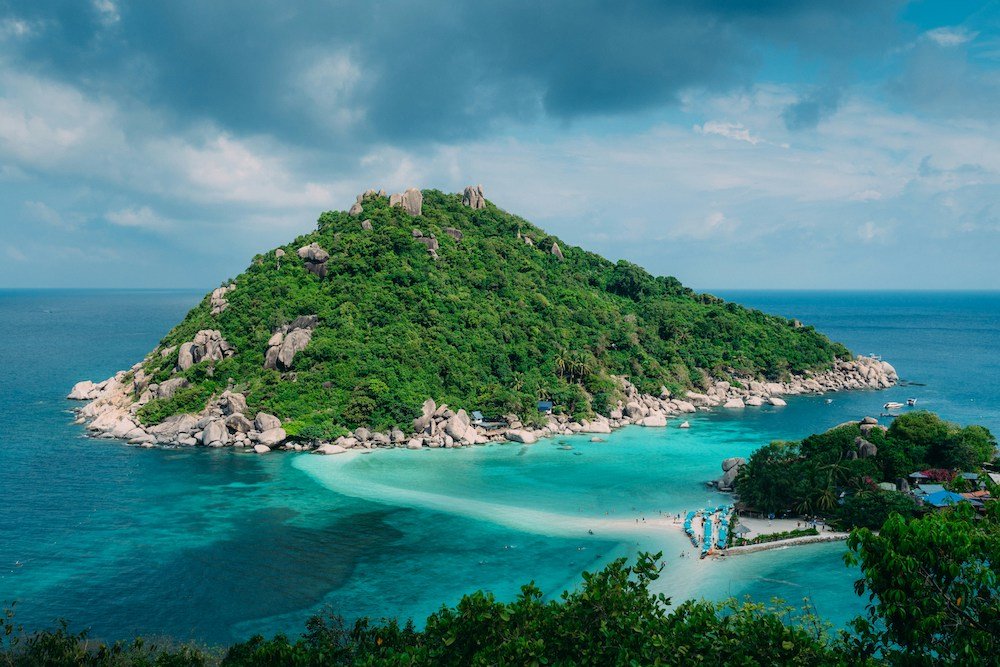
FAQ’s About Volcanic Islands:
What is a volcanic island?
A volcanic island is an island formed through the eruption of volcanoes, typically emerging from the ocean floor due to volcanic activity.
These islands are created when magma rises from the Earth’s mantle and erupts onto the surface, eventually solidifying into landmasses.
Which islands have volcanoes?
Many islands around the world have volcanoes, as they are often located along tectonic plate boundaries or hot spots where volcanic activity is prevalent.
Some notable examples include Hawaii, Japan, Indonesia, the Philippines, Iceland, and the Canary Islands.
What is the largest volcanic island in the world?
The largest volcanic island in the world is the island of Honshu in Japan.
It is home to several active and dormant volcanoes, including Mount Fuji, one of Japan’s most iconic symbols.
What are the two types of volcanic islands?
The two main types of volcanic islands are:
- Oceanic Volcanic Islands: These islands form along divergent plate boundaries or hot spots in the middle of oceanic plates. Examples include Hawaii and the Galapagos Islands.
- Continental Volcanic Islands: These islands are formed by volcanic activity associated with subduction zones, where one tectonic plate is forced beneath another. Examples include the islands of Japan and Indonesia.
What is a series of volcanic islands called?
A series of volcanic islands is often referred to as an island chain or an island arc.
These chains or arcs are typically formed along the boundaries of tectonic plates, where volcanic activity is common.
What is an example of a volcanic island?
One example of a volcanic island is Santorini, located in the Aegean Sea in Greece.
Santorini is known for its stunning landscapes, including its crescent-shaped caldera, which was formed by a massive volcanic eruption thousands of years ago.
Is Fiji a volcanic island?
Yes, Fiji is a volcanic island.
The islands of Fiji were formed through volcanic activity millions of years ago and are part of the Ring of Fire, a region known for its high volcanic activity and frequent earthquakes.
Many of Fiji’s islands are characterized by lush rainforests, pristine beaches, and volcanic landscapes.
